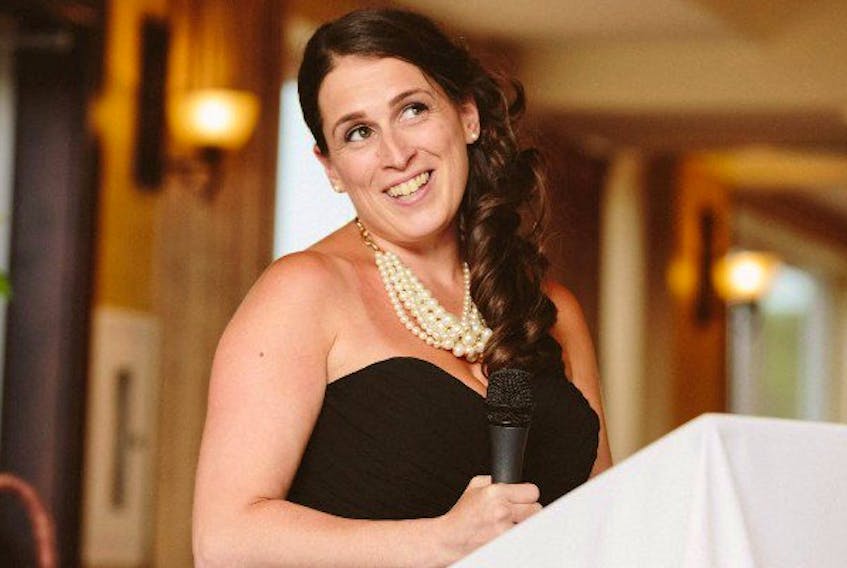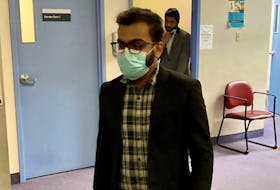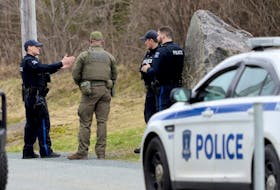Closing arguments wrapped up Wednesday at a Halifax murder trial, with one of the defence lawyers saying the two accused were not responsible for the stabbing death of Nadia Gonzales at a Dartmouth apartment building in June 2017.
Malcolm Jeffcock, who represents Calvin Maynard Sparks, pointed his finger at three men who were arrested in a nearby parking lot more than two hours after the killing but were released the next morning and never charged.
Jeffcock questioned why police did not request DNA samples from the men, who had no visible injuries or blood on their clothing, and whether one of them was the source of male DNA found on Gonzales’ fingernails.
“We have a situation in this case that, in my respectful submission, is a case of tunnel vision,” the lawyer told the Nova Scotia Supreme Court jury.
“Tunnel vision is one of the most dangerous things we see in the criminal justice system. An investigation should follow all avenues of inquiry, not grab hold of one that is presented at the very outset and then only seek to interpret evidence in view of that scenario.
“I would suggest to you that that is the basis for wrongful convictions in this and other provinces.”
Sparks, 26, of Dartmouth, and Samanda Rose Ritch, 22, of Halifax are charged with first-degree murder and attempting to murder a man who was with Gonzales on the night of the killing.
Gonzales, 35, of Hammonds Plains, died at an apartment building at 33 Hastings Dr. on June 16, 2017. She was stabbed between 30 and 40 times and placed in a hockey bag that was discovered on a landing in the building’s west stairwell.
Police arrested Sparks and Ritch the next morning on Federal Avenue in Halifax. Both had bandages on fresh cuts on their hands.
The Crown alleges Sparks and Ritch armed themselves with knives and attacked Gonzales and John Patterson in the hallway outside apartment 16 on the fourth floor of the Hastings Drive building.
Patterson testified that he and Gonzales went to the apartment that night to deliver crack cocaine to tenant Wayne (Batman) Bruce. Patterson was stabbed six times before making his way outside and collapsing on the front lawn of an elementary school across the street.
In his closing arguments Tuesday, Crown attorney Rob Kennedy said the evidence establishes that Sparks came up with a plan to kill Gonzales because he was jealous of her financial success as a drug dealer, believed she was an informant and couldn’t tolerate her calling him a rat.
The prosecutor said Sparks enlisted the assistance of Ritch, who shared details of the killing with an undercover female officer in cells at the Halifax police station on the night of June 17, 2017.
The undercover officer said Ritch told her that her ex had stabbed a girl about 30 times and put her in a duffel bag. Ritch allegedly stated that she didn’t stab the girl but helped put her in the bag and that the girl had scratched her in the face.
Ritch also allegedly told the officer that her ex had stabbed her in the left ring finger during the incident.
A DNA expert testified that Sparks’ blood was found on clothing and one of the shoes worn by Gonzales, on the hockey bag in which her body was placed, and in the stairwell where the bag was discovered.
His DNA was also on a knife found under shrubs on a nearby property, on a fence and on grass near where the knife was located, on a T-shirt and the shoes Ritch was wearing when she was arrested, on Gonzales’ Taser that was found at Ritch’s house, and in a Honda Accord that was impounded from a Halifax parking lot more than 24 hours after the killing.
Ritch’s DNA was present in fingernail clippings taken from Gonzales’ right hand, the expert said.
In his remarks to the jury Wednesday, Jeffcock said the Crown’s case was based on police tunnel vision and the evidence of four key witnesses – including Patterson and Bruce, both longtime crack addicts and dealers – who are not worthy of belief.
The lawyer reminded jurors that Bruce and Joe Fowler, who claimed Sparks had asked him to kill Gonzales, each admitted lying on the stand under oath.
Jeffcock proposed that someone else knew Gonzales was going to be at the building that night and attacked her. He read out a series of text messages from earlier that evening that indicate Jacob Sparks, one of the three men later arrested and released, thought Gonzales was a rat and wanted her to meet with him alone.
“Once the perpetrators were engaged with John and Nadia, creating significant noise that was heard all the way down the hall, the two people who are here in court charged with this offence went outside the apartment into a world of trouble from which they were in fact lucky to escape,” Jeffcock said.
“They left the area because they were scared and injured. They didn’t get on a train or a plane or a bus and get out of Nova Scotia. … They went to Samanda’s brother’s house, where they were quickly located by police.”
Jeffcock said the hand injuries suffered by Sparks and Ritch are consistent with defensive wounds. He said severe cuts on the inside of Sparks’ right hand could have been from grabbing a knife being held by a perpetrator and suggested his client picked a knife up off the floor “out of self-preservation” and took it with him as he fled the scene.
Sparks would have been bleeding profusely from his injuries as he left the scene, Jeffcock said.
“There’s all manner of possible explanations as to how his blood came to be on Ms. Gonzales and the bag,” he said. “The fact that Mr. Sparks is probably in all likelihood bleeding from both hands only doubles the opportunity for his DNA to be distributed and fall hither and yonder.”
Jeffcock called his version of events “a realistic and viable alternative” to the theory of the Crown and said the defence does not have to prove that other people committed the crime.
“The Crown has to prove to you beyond a reasonable doubt they didn’t, and that in fact it was the two people before you today,” he said.
“Based on all of the evidence, you should at least have a reasonable doubt as to who the perpetrator of this crime was.”
On Tuesday, the other defence lawyer, Peter Planetta, said his client acted as an accessory after the fact but should be found not guilty as charged.
Justice Christa Brothers started giving her final instructions to the jury Wednesday. The eight male and four female jurors are expected to begin deliberating Thursday.









